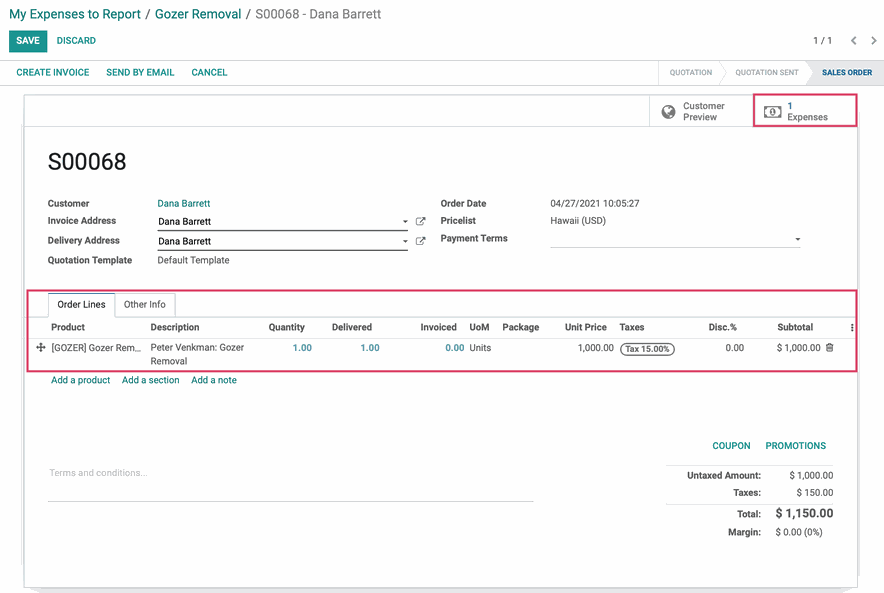Accounting: Configuration: Expenses
Purpose
The purpose of this documentation is to outline the use cases and processes associated with the Odoo 14 Expenses application. We'll go over the app configuration, as well as Expense Product configuration.
We'll then show you how to submit, post, approve, and charge expenses to the client.
Process
To get started, navigate to the Expenses app.

Configuring Expenses
Within the Expenses application, click on CONFIGURATION > SETTINGS. Here you'll see the following options:
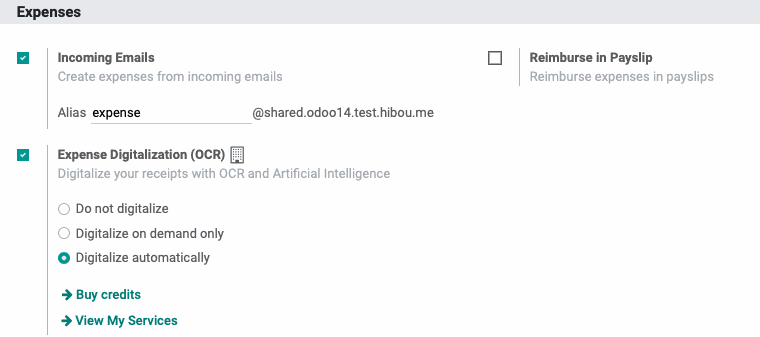
Emails: If selected, you will enter an email alias where expenses can be emailed to in order to generate expenses.
Reimburse in Payslip: Select this option to reimburse via payslip rather than separate payments.
Expense Digitalization (OCR): This is a paid Odoo feature that will digitalize scanned/uploaded receipts for a more automated method of expense entry into the Expenses app. We will not be covering this functionality in our documentation, but if you need help, please contact us.
When you're done, click Save.
Expense Products
Expense Products are products that have the 'Can be Expensed' checkbox selected. Click CONFIGURATION > EXPENSE PRODUCTS to see a kanban view of Expense Products, if any exist.
To create a new Expense Product, click CREATE. Complete the following form according to these guidelines:
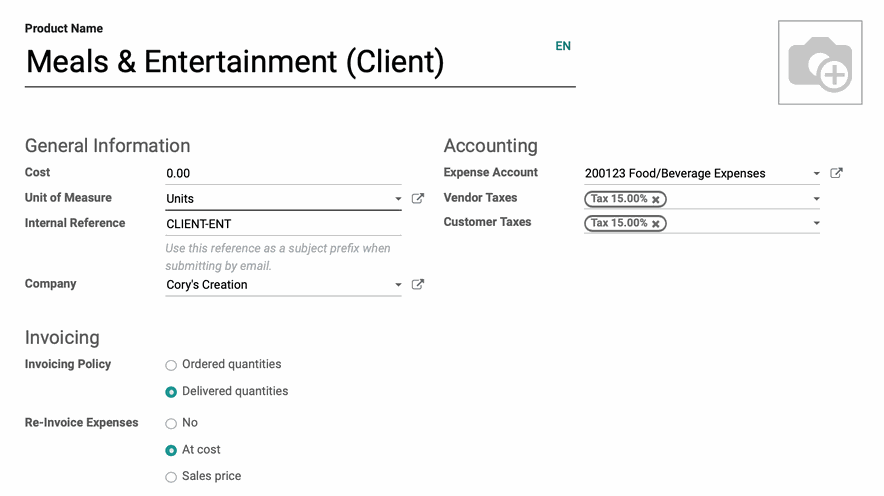
Product Name: The name of the expense. Here are some common expense products to serve as examples:
Travel Expenses [Internal]: Used for airfare, car rental, hotels and other similar expenses that are associated with travel that is not being invoiced back to a customer.
Travel Expenses [Client]: Used for airfare, car rental, hotels and other similar expenses that are associated with client travel and will be invoiced back to a customer.
Meals and Entertainment [Internal]: Used for meals and food purchases that will not be invoiced back to a customer.
Meals and Entertainment [Client]: Used for meals and food purchases that will be invoiced back to a customer.
Other Products: Various broad products for other expenses, such as office supplies.
General Information
Cost: This can be configured to have a set cost, but you may wish to leave this at $0 and set the price appropriately on each expense.
Unit of Measure: Enter the unit of measure for this product (e.g. each, per unit).
Internal Reference: When emailing expenses, this code will serve as a subject prefix when submitting expenses via email.
Company: If you're in a multi-company environment, leave this blank to apply to all companies. Otherwise, select the individual company this should apply to.
Accounting
Expense Account: This should be an expense account that makes sense for the type of product. For example, Travel Expenses are assigned a Travel Expenses expense account. Here are some example expense product and account matchups:
Travel Expenses [Internal]: 220107 Travel Expenses
Travel Expenses [Client]: 220107 Travel Expenses
Meals and Entertainment [Internal]: 220150 Meals and Entertainment Expenses (50%)
Meals and Entertainment [Client]: 220108 Meals and Entertainment Expenses (Client)
Other Products: An existing expense account that makes sense given the nature of the product (Supplies Expenses for office supplies, for example
Vendor Taxes: Taxes that are automatically applied when this expense is purchased.
Customer Taxes: Taxes that are automatically applied when this expense is sold
Invoicing
Invoicing Policy: Select when this expense should be invoiced back to the customer, when applicable.
Re-Invoice Expenses: This should be set to 'No' for all expenses that will not be invoiced back to a client. If it will be invoiced back to a client, this should be set to 'At cost' or 'Sales price'.
When you're ready, click SAVE.
Important!
Configuring Products for Expenses that Will be Invoiced Back to Clients
If you are creating an expense product for an expense that will be invoiced back to the client at cost, don't create your expense product here. Instead, go through the Sales or Inventory applications to create the products. This gives you more control over the product configuration.
For these products, the following details still apply but you'll also want to configure the Income Account and the Expense Account (under the Accounting tab) to use the same expense account, allowing the account to wash out since the cost and the revenue will match.
Submitting Expenses
Employees can submit their own expenses, and those with proper permissions can submit expenses on behalf of employees.
To submit an expense, click MY EXPENSES > all MY EXPENSES. Once there, click Create and enter details in the following form.
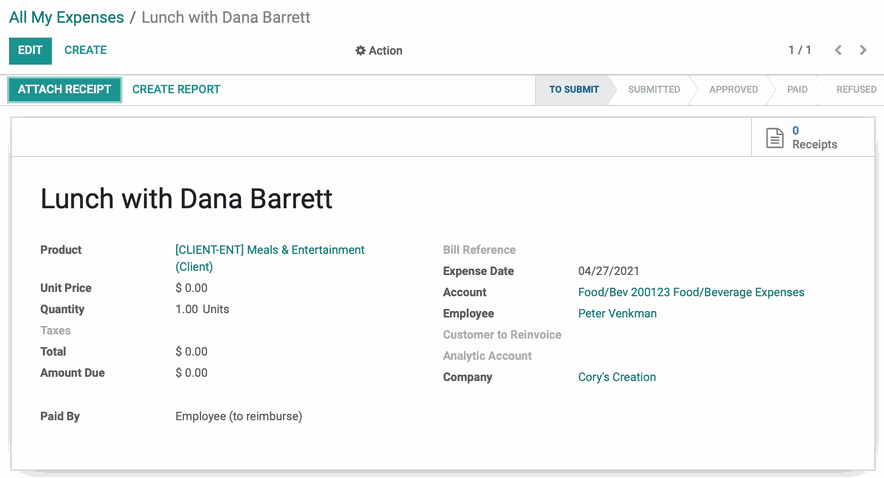
Description: Describe the expense including enough details to make it easily identifiable ('Hotel for Trip to X Client', for example)
Product: Choose the appropriate expense product
Unit Price: Set the price based on the receipt total.
Quantity: Will typically be a quantity of one, unless multiple of the product were purchased on the same day at the same price.
Taxes: Typically none.
Total: This is calculated based on the Unit Price and Quantity fields. It cannot be manually changed.
Bill Reference: Something like a receipt or order number.
Expense Date: The date the purchase was made.
Account: An appropriate expense account, as described above (usually filled by the product)
Employee: Select the employee responsible for the expense (usually yourself).
Reinvoice Customer: If the customer is to be invoiced for this expense, select the related Sales Order from the drop-down.
Analytic Account: If needed (e.g. to bill to a project like potentially large trips or marketing initiatives), or potentially an Analytic Account that is related to the Sale Order chosen earlier.
Analytic Tags: Add any relevant tags for reporting purposes.
Company: Select the company reimbursing this expense.
Paid By: Indicate who paid this initial expense.
Employee (to reimburse): Select this option if an employee made the purchase and needs to be reimbursed.
Company: Select this option if the company paid for the purchase and no reimbursement is needed.
When you've completed the form, click Save. Next, click Attach receipt and upload the receipt for this purchase.

Once you've uploaded your document(s), you'll also see the Receipts smart button with an updated total of attachments added. The attachment(s) can also be found in the chatter.
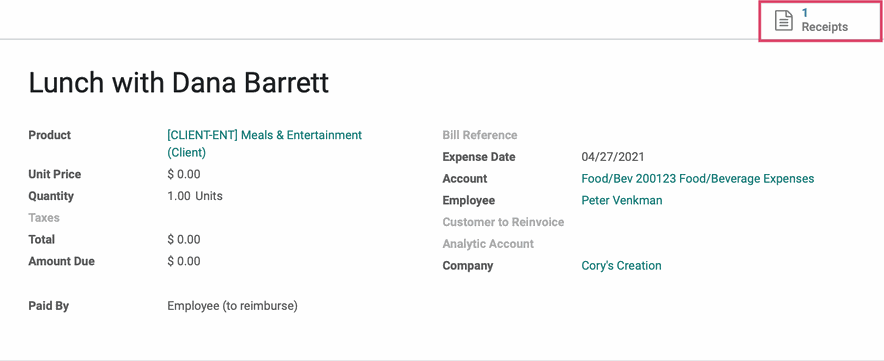
If everything looks correct, click Create Report.

This will take you to a draft Expense Report Summary where most of the data you've entered will be populated. It will include information for all expenses not yet submitted.
Review the information on this page. When you're ready, click Save (if it shows as an option). You can then click Submit to Manager if your expense requires approval. If you are a manager, you can click approve.

Batch Expenses
You can submit several reports at once through My Expenses > All my expenses. Simply select all reports to submit, then click Action > Create Report. This brings you to the draft Expense Summary Report we covered, above.

Good to Know!
Sometimes when you transition from an expense to the expense summary, the document count won't update. You can click Save on the summary and reload the page to make sure the count is correct.
Approving Expenses
As an administrator, you can review pending expenses by clicking Expense Reports >reports to Approve.
Here you will see expense reports that have been submitted and await approval. Click into the individual report.

If the expense has been created correctly and the appropriate documentation has been attached, click APPROVE. This will move it to the next stage where you'll Post the expenses.
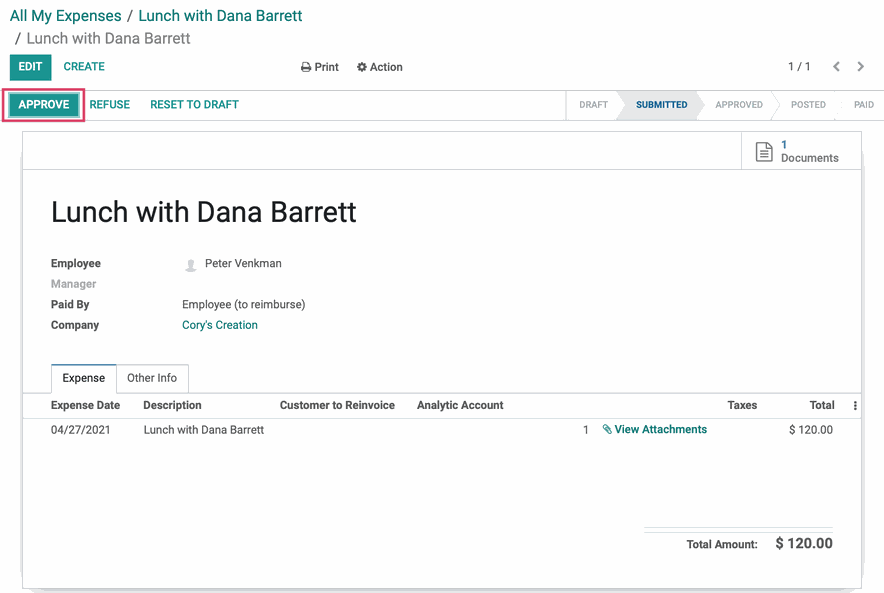
If the expense wasn't submitted correctly, like the following example which is missing receipts, click Refuse.

Enter a reason for refusal, then click Refuse again.

Posting Expenses
If you're not coming directly from an approved invoice, you can view the reports ready to post by clicking Expense Reports > Reports to Post and selecting an expense to post from the list.
This page is your final review. If everything still looks correct, click POST JOURNAL ENTRIES.
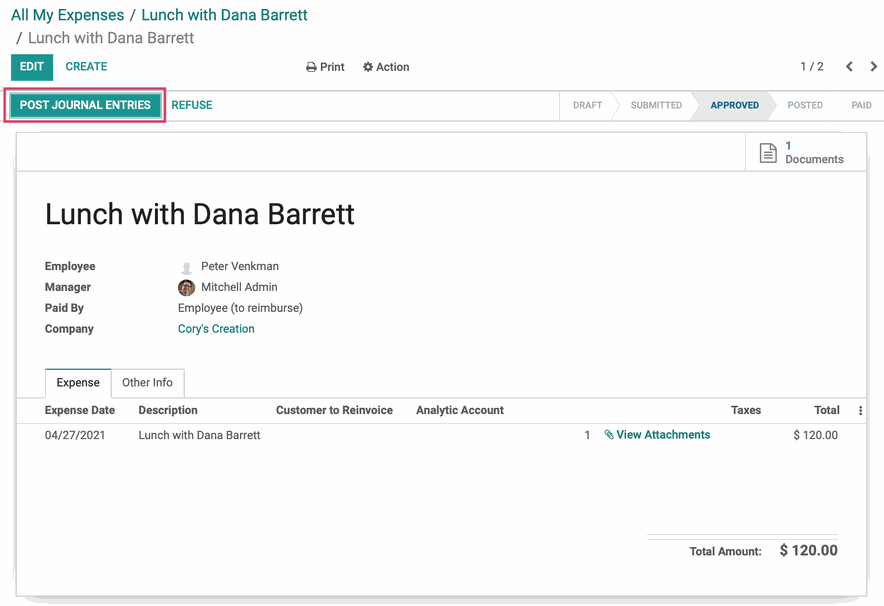
Once entries are posted, one of two things will happen.
If Paid By was set to Company, there will be no further action until the charge hits a card or bank, at which point it will be reconciled. This expense will be marked as Paid as well as show a green PAID banner in the top right corner.
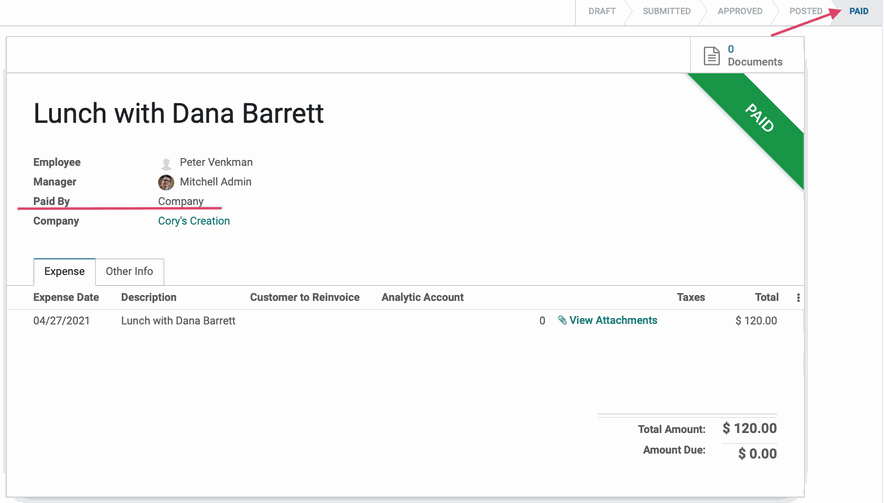
If Paid By was Employee (to Reimburse), the status will change to Posted and you'll have the option to Register Payment directly from the expense. The unpaid expense will also be listed under Expense Reports > reports tO PAY where you'll be able to register payment.
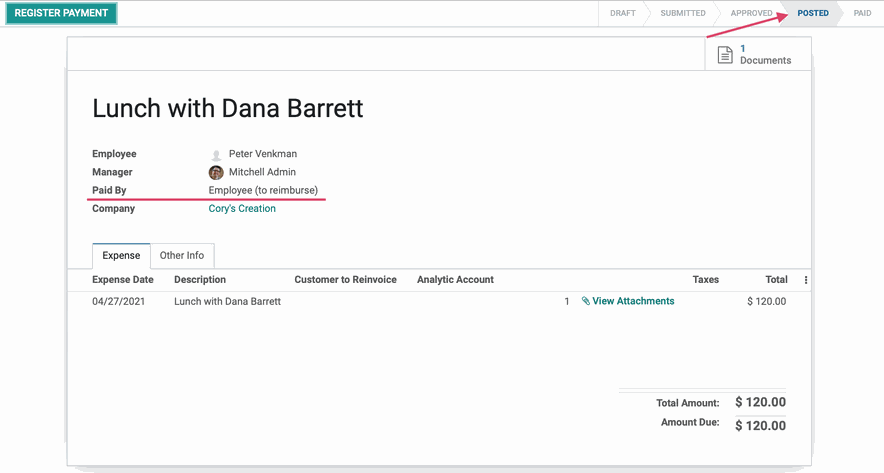
Re-Invoicing to Clients
In this example, we're clicking Approve on an expense configured to "Reinvoice Customer". You'll see the related, open Sales Order in the Expense lines.
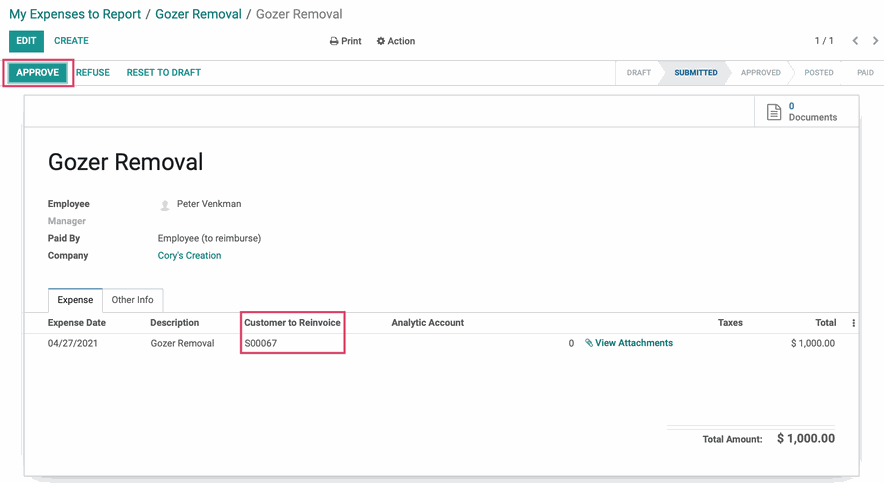
Next, we'll click Post Journal Entries on the approved expense.
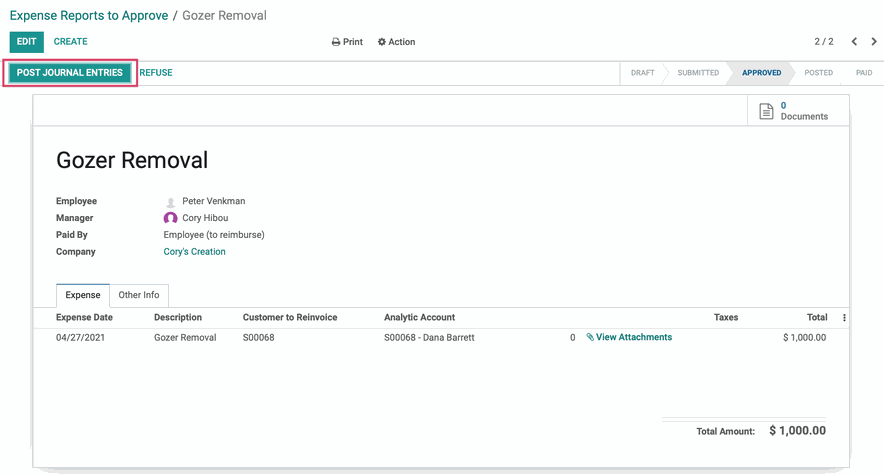
To review the Sale Order, click the expense line:

Then click the Sale Order reference number next to Customer to Reinvoice:
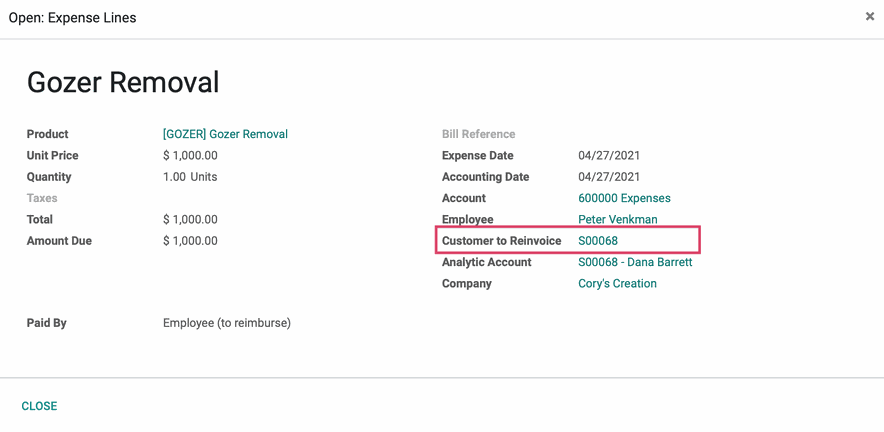
On the Sale Order, you can see the entry was created and there's a smart button that links back to the related Expenses.
